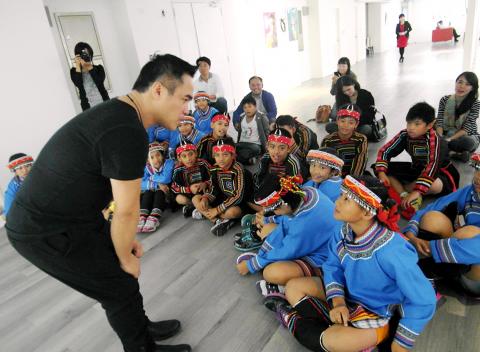Yosifu, a fine arts painter and Amis Aborigine, has just completed an art workshop for some of Taitung’s Aboriginal youth.
“I came back [to Taiwan] and did it because I wanted to give back to my people and help other indigenous artists develop,” he told the Taipei Times.
Yosifu, who lives in Edinburgh, promotes Taiwan’s indigenous culture throughout Europe.

Photo courtesy of the Taiwan Cultural & Creative Platform Foundation
As one of the first Taiwanese Aborigines to achieve international artistic success and recognition, he typifies the need for involvement at the grassroots level.
The Council of Indigenous Peoples and government agencies can set policies and hold conferences such as the recent 2013 International Austronesian Conference, but the level, extent and degree to which policies and actions are carried out often depends more on people at the grassroots level. Fortunately, in Taiwan that level is increasing.
There’s no one event or phenomenon that triggered this recent grassroots surge of involvement, though the increased use and ability of Facebook, YouTube and other social media may be a factor. In addition, art is a common denominator in many of the new grassroots projects.
Elise Tseng (曾珮貞) left a career in the art industry in 2011 to take charge of the Taiwan Cultural & Creative Platform Foundation.
“I saw that despite Taiwan having many artists, [art] had not yet touched and explored its basic base, namely its indigenous people,” Tseng said.
Her foundation sponsors workshops such as the one held by Yosifu. After researching Australian models of promoting indigenous culture, Tseng and the foundation used them to organize art and festivals.
“We strive to show [Aborigines the] environment of the urban city that they will face as artists and [encourage them] to dream big.” Dream Big is in fact the title of one of their projects.
A different unique story is that of American Tony Coolidge, who discovered his Atayal heritage when living in the US. This led to his involvement with indigenous peoples and the founding of Atayal, a nonprofit organization that tries to bring together indigenous cultures from around the world. His award-winning film Voices in the Clouds premiered in 2010.
“It was my personal roots trip back to my heritage,” Coolidge said.
Earlier this month, Coolidge spearheaded a project called Tap Root, a Journey of Self-Discovery, in which Maori film students from New Zealand toured Taiwan and shared their Austronesian culture and experiences. This is not without some irony since they arrived during the 2013 International Austronesian Conference but were not acknowledged by it.
Kolas Yotaka, a producer and presenter at Taiwan Indigenous TV, says that art is not the only platform for involvement. Some groups focus on political issues — Yotaka named the Taiwan Indigenous Tribal Movement League (台灣部落行動聯盟) led by Omi Wilang of the Taiwan Presbyterian Church, and the Smoke Signals League.
“But even with the political, art can take a supportive role,” Yotaka said.
Art and culture certainly seem to be the vehicle that allows all to get involved.
Minna Hsu (徐敏娜), a Taiwanese American working on a Ph.D in Human Geography at Macquarie University in Sydney, Australia, decided to join the newly formed Austronesian Cultural and Economic Cooperative Association because she believes that it is important to “promote awareness of and cooperation between the indigenous cultures of Taiwan and abroad.”
Taiwan’s expat community is also finding art to be a less threatening environment for involvement. Jonathan Burke, a director in the customer service field, is a permanent resident in Taiwan who has long been involved in volunteer work.
“It is an expression of my Christian faith to assist and help socially marginalized groups.”
In 2011, he started participating in photography workshops that help Aboriginal youth expand their artistic expression.
Yosifu says government assistance is important, but that the grassroots may be where it’s at, and that art is proving to be the medium.
“I came to find a sense of pride and acceptance in Europe first by trying modern art. Success there led me to realize I should also be proud of my indigenous heritage and incorporate that into my art. I even took back my tribal name, Yosifu. Now I return regularly to help others,” he said.

In recent weeks the Trump Administration has been demanding that Taiwan transfer half of its chip manufacturing to the US. In an interview with NewsNation, US Secretary of Commerce Howard Lutnick said that the US would need 50 percent of domestic chip production to protect Taiwan. He stated, discussing Taiwan’s chip production: “My argument to them was, well, if you have 95 percent, how am I gonna get it to protect you? You’re going to put it on a plane? You’re going to put it on a boat?” The stench of the Trump Administration’s mafia-style notions of “protection” was strong

Every now and then, it’s nice to just point somewhere on a map and head out with no plan. In Taiwan, where convenience reigns, food options are plentiful and people are generally friendly and helpful, this type of trip is that much easier to pull off. One day last November, a spur-of-the-moment day hike in the hills of Chiayi County turned into a surprisingly memorable experience that impressed on me once again how fortunate we all are to call this island home. The scenery I walked through that day — a mix of forest and farms reaching up into the clouds

With one week left until election day, the drama is high in the race for the Chinese Nationalist Party (KMT) chair. The race is still potentially wide open between the three frontrunners. The most accurate poll is done by Apollo Survey & Research Co (艾普羅民調公司), which was conducted a week and a half ago with two-thirds of the respondents party members, who are the only ones eligible to vote. For details on the candidates, check the Oct. 4 edition of this column, “A look at the KMT chair candidates” on page 12. The popular frontrunner was 56-year-old Cheng Li-wun (鄭麗文)

“Eighteen years ago, people didn’t even know the name of this ingredient,” says 58-year-old Gil Sa-hyeon, holding up a cluster of dried brownish stems. “Now it’s everywhere.” His shop, Joseon Yakcho, sits in the heart of Seoul’s Yangnyeongsi Market, South Korea’s largest traditional medicinal herb market, its streets lined with shops displaying buckets of herbs such as licorice root and cinnamon bark that spill on to the pavements, filling the air with their distinct, earthy aroma. The ingredient Gil is referring to is hovenia dulcis, known in Korean as heotgae — the oriental raisin tree that’s become the cornerstone of South Korea’s